Difference between revisions of "Sony Interactive Entertainment"
Jump to navigation
Jump to search
(Created page with "<div class="WPC-editableContent" id="WPC-area?cellId=Sony+Interactive+Entertainment&version=201&savePath=%2Fpage%2FSony%2BInteractive%2BEntertainment&saveType=page...") |
|||
| Line 1: | Line 1: | ||
| − | <div class="WPC-editableContent" id="WPC-area?cellId=Sony+Interactive+Entertainment&version=201&savePath=%2Fpage%2FSony%2BInteractive%2BEntertainment&saveType=page"><font size="3"><i><font color="#ffa500">Logo captures by</font> mr3urious and ENunn</i></font><div><font size="3"><font size="3"><font><i><font color="#ffa500">Editions by</font> mr3urious, sega3dmm, Wyraachur, KirbyGuy2001 (Logoblin), and zman1997</i><br/><br/><br/><u>Background</u>: Sony Interactive Entertainment (SIE formerly "Sony Network Entertainment" and "Sony Computer Entertainment") was founded and established on November 16, 1993 in Tokyo, Japan as a subsidiary of Sony to create the PlayStation video game console. The PlayStation was the result of Nintendo and Sony teaming up to try to create a CD add-on for the Super Nintendo Entertainment System (SNES for short). However, the deal said that Sony must license the SNES-CD games and not Nintendo. This betrayed Nintendo, and they asked Philips to create the add-on, and the deal was accepted. Once Sony heard about Nintendo and Philips' collaboration which gave Sony "a taste of their own medicine", they went on to independently develop a CD-based game console, the PlayStation. It was a success, leaving Sony to make more PlayStation consoles (including the PlayStation 2, which has gone on to become the best-selling console of all time, at sales of over 150 million units worldwide), even a portable console called the PSP. Philips went on to create four <font color="#333333">video games for their CD-i, since they still had some of the licenses from Nintendo's characters. They continued to make a successful line of consoles and handhelds, such as the PlayStation 3, the PlayStation Vita, and most recently the PlayStation 4. In April 2016,</font></font> Sony Computer Entertainment and Sony Network Entertainment was restructured and reorganized into Sony Interactive Entertainment, carrying over the operations and primary objectives from both companies.</font><font><font color="#333333"><font size="3"><br/><br/></font><br/></font><font size="3"><font color="#333333">1st Logo<br/></font>(December 3, 1994-March 23, 2006, December 3, 2018- )</font><br/> </font></font><div align="center"> <font size="1"> | + | <div class="WPC-editableContent" id="WPC-area?cellId=Sony+Interactive+Entertainment&version=201&savePath=%2Fpage%2FSony%2BInteractive%2BEntertainment&saveType=page"><font size="3"><i><font color="#ffa500">Logo captures by</font> mr3urious and ENunn</i></font><div><font size="3"><font size="3"><font><i><font color="#ffa500">Editions by</font> mr3urious, sega3dmm, Wyraachur, KirbyGuy2001 (Logoblin), and zman1997</i><br/><br/><br/><u>Background</u>: Sony Interactive Entertainment (SIE formerly "Sony Network Entertainment" and "Sony Computer Entertainment") was founded and established on November 16, 1993 in Tokyo, Japan as a subsidiary of Sony to create the PlayStation video game console. The PlayStation was the result of Nintendo and Sony teaming up to try to create a CD add-on for the Super Nintendo Entertainment System (SNES for short). However, the deal said that Sony must license the SNES-CD games and not Nintendo. This betrayed Nintendo, and they asked Philips to create the add-on, and the deal was accepted. Once Sony heard about Nintendo and Philips' collaboration which gave Sony "a taste of their own medicine", they went on to independently develop a CD-based game console, the PlayStation. It was a success, leaving Sony to make more PlayStation consoles (including the PlayStation 2, which has gone on to become the best-selling console of all time, at sales of over 150 million units worldwide), even a portable console called the PSP. Philips went on to create four <font color="#333333">video games for their CD-i, since they still had some of the licenses from Nintendo's characters. They continued to make a successful line of consoles and handhelds, such as the PlayStation 3, the PlayStation Vita, and most recently the PlayStation 4. In April 2016,</font></font> Sony Computer Entertainment and Sony Network Entertainment was restructured and reorganized into Sony Interactive Entertainment, carrying over the operations and primary objectives from both companies.</font><font><font color="#333333"><font size="3"><br/><br/></font><br/></font><font size="3"><font color="#333333">1st Logo<br/></font>(December 3, 1994-March 23, 2006, December 3, 2018- )</font><br/> </font></font><div align="center"> <font size="1">[[File:Rh5PO6YjM-xtptz2YaiyGA8014.jpeg|260px|Sony Computer Entertainment]]<embed height="196" src="http://wikifoundrytools.com/wiki/closinglogos/widget/youtubevideo/8872f882ec625c84b9e685564190aba49ee38654" type="application/x-shockwave-flash" width="241" wmode="transparent"/></font></div> <font size="3"><font size="3"><br/><u>Logo</u>: We fade into a white background, then an <font color="#ffa500">orange<font color="#000000">/<font color="#ffff00">yellow<font color="#000000"> gradient</font></font></font><font color="#333333"> diamond appears. After that, two triangles appear on the diamond in an "S" shape. After it's </font></font></font><font color="#ffa500"><font color="#333333"><font size="3">completed:</font><br/></font></font><br/> </font><div align="center"> </div> <div align="center"><font size="3"><b> </b><font color="#ffa500"><font color="#000000"><font color="#ffff00"><font color="#000000"><font color="#0000ff"><font size="5"><b><font color="#0c1f8a" face="Times">SONY</font></b></font><font color="#0c1f8a" face="Times"><font color="#333333"><font face="Arial"><br/><br/><br/><font size="4"><br/></font></font></font></font></font></font></font></font></font><b><font color="#0c1f8a" face="Helvetica"><font size="4">COMPUTER</font> </font><br/><font color="#0c1f8a" face="Helvetica" size="2">ENTERTAINMENT</font></b></font></div> <div align="center"> </div> <div align="center"> </div><font size="3"><br/><font><font><font><font><font><font size="3"><font color="#333333">appears in a </font><font color="#161363">dark blue</font><font color="#333333"> color, with "<font color="#0c1f8a"><b><font face="Times">SONY</font></b></font>" in its corporate font (actually a variation of the Clarendon typeface font).</font><br/><br/><font color="#333333"><u>Variants</u>:<br/></font></font></font></font></font></font></font></font><ul><li><font color="#ffa500"><font color="#000000"><font color="#ffff00"><font color="#000000"><font color="#0000ff"><font color="#000000" size="3"><font color="#333333">On earlier generation PlayStation consoles (SCPH-100x series to SCPH-555x series), the Sony Computer Entertainment text is larger and</font> <font color="#333333">the trademark symbol is on the right of the diamond instead of the "COMPUTER ENTERTAINMENT" text.</font></font></font></font></font></font></font></li><li><font size="3"><font color="#ffa500"><font color="#000000"><font color="#ffff00"><font color="#000000"><font color="#0000ff"><font color="#000000"><font color="#333333">From the SCPH-700x onwards, however, the SCE text is a bit smaller. Also</font></font></font></font></font></font></font> on pretty much all the original PlayStation consoles, when the above logo appears, a TM sign appears next to the logo.</font></li><li><font size="3">On the PSone, a registered trademark sign appears next to the logo.</font></li><li><font size="3">On very early Japan-region consoles, the sound can still be heard fading out over the menu screen</font></li><li><font size="3">On the PlayStation Classic, the diamond is smaller and moved to the left, and “Sony Interactive Entertainment” fades in next to it..</font></li></ul><font size="3"><br/><font color="#333333"><u>FX/SFX</u>: The diamond, two triangles, and text appearing.<br/><br/></font><font color="#333333"><u>Music/Sounds</u>: A synth bass note with chimes ringing, followed by another bass note, which often continues to the PlayStation logo of the time. Note that the music starts before we even fade into the white background.</font></font></div><div><font size="3"><font color="#333333"><br/></font></font></div><div></div><div><font size="3"><font color="#333333"><u>Music/Sounds Trivia</u>: The music's sequence is generated by 3 integrated PCM sound files which come from the BIOS software (the chimes, bass note and a "shattering"-like reversed sound); all of them are being played in different speeds and pitches than the original samples (also processed in reverb). This is also the same with the following PlayStation logo.<br/></font></font></div><div><font size="3"><font color="#333333"><br/></font></font></div><div><font size="3"><font color="#333333"><u>Availability</u>: Appears when you turn on a Sony PlayStation or its compact re-design, the PSone. Still used as a print logo on slipcases of first-party PlayStation games. The logo is obviously not seen when you play a PlayStation 1 game on the PlayStation 2 or 3.</font></font><div><font size="3"><font color="#333333"><font size="3"><br/><u>Editor’s Note</u>: Many people consider this one of the greatest console startups due to its unique sound and nostalgia factor.</font></font><br/><font color="#333333"><br/><br/></font><font size="3"><font><br/></font></font></font></div><div><font size="3"><font size="3"><font>2nd Logo<br/></font><font color="#333333">(December 3, 1994- )<br/><br/></font></font><font color="#333333"><font size="3"><u>Logo</u>: On a plain black background, we see text saying:</font><br/><br/></font></font><div align="center"><b><font size="3"><font>Sony Computer Entertainment Inc.<br/></font><font>Presents</font></font></b></div><font size="3"><font><font color="#333333"><br/><font size="3">in a Helvetica-like font.</font></font><font size="3"><font color="#333333">It usually appears after the PlayStation logo on Japanese/NTSC-J and North American/NTSC-U/C PlayStation games, but on European/PAL games, it usually appears after the piracy warning (which is common on PAL PlayStation games from 1995 to 1999).</font><br/><font color="#333333"><br/></font><font color="#333333"><u>Variant</u>: Like the first [[PlayStation]] logo, there are regional variants. The version mentioned above is normally used on games from Japan, but there are also North American and European variants. There are also countless other variants of this logo, for instance, font differences and backgrounds. Later versions say “Sony Computer Entertainment presents” and most recently, “Sony Interactive Entertainment presents”.<br/><br/></font><font color="#333333"><u>FX/SFX</u>: None or the fading in/fading out.<br/><br/></font><font color="#333333"><u>Music/Sounds</u>: None or some music from the game.<br/><br/></font><font color="#333333"><u>Availability</u>: Common. It appears on many games developed and/or published by Sony Computer Entertainment for the PlayStation consoles. The first game to use this logo was the Japan-only PlayStation launch title <i>Crime Crackers</i>.<br/></font></font></font><font size="3"><font><br/><br/><br/></font></font></font><div><font size="3">3rd Logo</font></div><font size="3"><font color="#ffa500"><font color="#000000"><font color="#ffff00"><font color="#000000"><font color="#0000ff"><font color="#000000"><font color="#333333">(March 4, 2000-January 4, 2013</font></font></font></font></font></font></font><font color="#ffa500"><font color="#000000"><font color="#ffff00"><font color="#000000"><font color="#0000ff"><font color="#000000"><font color="#333333">)<br/></font></font></font></font></font></font></font></font><div align="center"> <font size="1">[[File:Ef0d043c20190333865ef39949a1bd26.png|204px|Sony Computer Entertainment Boot (2000)]]<font color="#ffa500"><font color="#000000"><font color="#ffff00"><font color="#000000"><font color="#0000ff"><font color="#000000">[[File:2BEesaadJUMofAf4Xj036w7882.jpeg|210px|Playstation/Playstation 2/Playstation 3 - CLG Wiki]]</font></font></font></font></font></font><br/><embed height="158" src="http://wikifoundrytools.com/wiki/closinglogos/widget/youtubevideo/1944e9761fbcfe34defb264c77465f484645fb42" type="application/x-shockwave-flash" width="188" wmode="transparent"/><font color="#ffa500"><font color="#000000"><font color="#ffff00"><font color="#000000"><font color="#0000ff"><font color="#000000"><embed height="157" src="http://wikifoundrytools.com/wiki/closinglogos/widget/youtubevideo/ddb3fbd14304c74cf64dc350c40946fd9437cfc6" type="application/x-shockwave-flash" width="191" wmode="transparent"/></font></font></font></font></font></font></font></div><font size="3"><font><font color="#ffa500"><font color="#000000"><font color="#ffff00"><font color="#000000"><font color="#0000ff"><font color="#000000"><font color="#333333"> <br/><font size="3"><u>Logo</u>: </font></font></font></font></font></font></font></font><font size="3"><font color="#333333">On a black background with</font><font color="#0000ff"> </font><font color="#0000ff">blue</font><font color="#0000ff"> </font><font color="#333333">clouds and 5 dark, giant glass cubes, we see "Sony Computer Entertainment" in white fade in and fade out in the span of a few seconds. We also see four comets, colored </font><font color="#0000ff">blue</font><font color="#333333">, </font><font color="#00ff00">green</font><font color="#333333">, </font><font color="#ffa6e9">pink</font><font color="#333333">, and </font><font color="#ff0000">red<font> </font></font><font color="#333333"> (possibly to represent the colors of the shapes [X, Triangle, Square, and Circle, respectively] you find on the round buttons on a PlayStation controller). We slowly zoom into the blue cloud, tilting as we do so. After a few seconds, depending on a few things explained below, we suddenly zoom in and go to either the main menu, the PlayStation Broadband Navigator, the "Red Screen of Death" variant listed below, the PS2 logo, the PS1 logo, or the start of the DVD/CD if one is inserted.</font><br/><font color="#333333"><u><br/></u></font> </font></font><font size="3"> <font><font color="#333333"><u>Variants</u>:</font> </font></font></font><ul><li> <font size="3">How long we zoom into the blue cloud depends on a few factors; whenever there is a hard disk inserted, if the hard disk is corrupted, if the PSBBN is installed in the HDD, how long the console takes to boot up the software, etc. It ranges from instantaneous to about twenty seconds.</font></li><li><font color="#ffa500"><font color="#000000"><font color="#ffff00"><font color="#000000"><font color="#0000ff"><font color="#000000"><font color="#333333" size="3">Depending on how much data you have on a PS2 Memory Card, there will be white blocks all over the screen when you turn on the PS2. This only happens if a Memory Card and/or Memory Cards with saved data is inserted into the Memory Card slots. As the player plays a game more and more, its block will become an ever-growing tower with a misty trail behind it. The screen will be empty (as the picture on the top left shows) if there is no Memory Card inserted.</font></font></font></font></font></font></font></li><li><font size="3"><font><font><font><font><font><font color="#333333">There is also a variant referred to as the "Red Screen of Death." After we zoom into the blue clouds, we see </font><font color="#ff0000">red</font><font color="#333333"> clouds of mist or smoke spiraling around a moving </font><font color="#ff0000">red</font><font color="#333333"> light. </font></font></font></font></font></font><font color="#333333">A glass cube zooms into view and starts to revolve around the light as a message appears saying "Please insert a PlayStation or PlayStation 2 format disc." (this appears in a different language depending on what language your PlayStation 2 is set on, e.g. "Por favor, inserte un disco de formato PlayStation o PlayStation 2." in Spanish). Another glass cube that is further away from us comes into view from behind the text, and also revolves around the light.</font></font></li><li> <font color="#ffa500" size="3"><font color="#000000"><font color="#ffff00"><font color="#000000"><font color="#0000ff"><font color="#000000"><font color="#333333">When you first set up the PS2, after we zoom into the blue cloud, the "PS" symbol fades in, then fades out, with the "PS2" logo fading in, then out. The music can still be heard on both logos.</font></font></font></font></font></font></font></li></ul><font color="#333333" size="3"><u> <br/>FX/SFX</u>: The text fading in and out, the zoom-in onto the cloud.<br/><br/><u>Music/Sounds</u>: A whooshing, breathy synth jingle with bells, followed by a whoosh when we zoom into the cloud. When a PlayStation disc, a DVD/CD, or a hard drive is inside the PS2, there is no whoosh when we zoom into the cloud.</font></div><div><font color="#333333" size="3"><br/></font></div><div><font color="#333333" size="3"><u>Music/Sounds Trivia</u>: Similarly to the 1st logo, the music is generated from a sequence of different PCM audio files from the BIOS software (with about 17 included), all played in different pitches and playback speeds. The other sounds available are used for the RSoD screen, the PS2 logo, and the menu.<br/></font><div><font color="#333333" size="3"><br/></font></div><div><font size="3"><font color="#333333"><u>Music/Sounds Variants</u>: When the red background appears, there is a more tense synth jingle with a breathy humming sound, followed by the sounds of wind blowing and waves flowing.</font><br/></font></div><div><font size="3"><u><br/></u></font></div><div><font size="3"><u>Availability</u>: Appears when you turn on a PlayStation 2. The "Red Screen of Death" only appears when an unreadable disc (or a disc that is not a PS, PS2, DVD, or Audio CD disc) is inserted.<br/><br/><u>Editor's Note</u>: This is another nostalgic logo among gamers; however, the “Red Screen of Death” variant can catch many off guard.<br/></font><font size="3"><font color="#333333"> <br/></font></font></div><div><font size="3"><font color="#333333"><br/></font></font></div><div></div><div><font size="3"><font color="#333333"><br/></font></font></div><div><font size="3"><font size="3">4th Logo<br/>(December 12, 2004-December 2014)<br/><br/><u>Note</u>: A high-quality audio-only file of the logo can be heard <a href="https://instaud.io/private/48ad076b4338445f68145b61e10260e7942b54d3" target="_self">here</a>.<br/><br/></font><u>[[File:M-nM-zGg5HpwOyH0yfHXlw1748.jpeg|300px|Sony Computer Entertainment - CLG Wiki]]Logo</u>: On a black background, text reading "<font face="Helvetica"><b>Sony Computer Entertainment</b></font>" in white as positioned on the center of the screen. Behind it is a line of color starting to emerge. The text <font size="3">fades out and the line emerges, revealing a moving lava lamp-like background in a color depending on the month or selected in the settings. The XMB interface appears when there is no UMD in the latch or the UMD Auto-Start is turned off.</font></font></div><div></div><div><font size="3"><font size="3"><u>Variant</u>: On development kits running the pre-release 1.00 firmware, known as "Bogus", the text reads "Sony Computer Entertainment Inc." The music consists of a whoosh, and a dreamy synth crescendo.<br/></font></font></div><div><font size="3"><font size="3"><u><br/></u></font></font></div><div><font size="3"><font size="3"><u>FX/SFX</u>: Just the background moving.<br/><br/><u>Music/Sounds</u>: A soft and short five note synth-chime tune.<br/><br/><u>Availability</u>: This can be seen when you boot up a Sony PSP (not from stand-by mode), but if the theme is changed on a hacked PSP, you might not be able to see it. The "Bogus" variant is extremely rare.</font><br/><br/><font size="3"><br/></font></font></div><div><font size="3"><font size="3"><br/></font></font></div><div><font size="3"><font size="3">5th Logo<br/>(November 11, 2006-September 1, 2009)</font><br/> </font><div align="center"> <font size="1">[[File:Y74fPd3nqpY fxE4Mnka1A4421.jpeg|188px|Sony Computer Entertainment - CLG Wiki]][[File:Wa-A9T2XzJlJPwRs-ekXKQ14707.jpeg|188px|Playstation/Playstation 2/Playstation 3 - CLG Wiki]][[File:G51iz9QZkrjudvUxSVcsSQ12882.jpeg|251px|Playstation/Playstation 2/Playstation 3 - CLG Wiki]][[File:36861948c8546e41b2b87cd400f427ec.jpeg|252px|Sony Computer Entertainment (2006)]]<br/><embed height="149" src="http://wikifoundrytools.com/wiki/closinglogos/widget/youtubevideo/b7569ffe61fa338562f92e104b18740e276d9a48" type="application/x-shockwave-flash" width="186" wmode="transparent"/><iframe frameborder="0" height="150" src="http://wikifoundrytools.com/wiki/closinglogos/widget/genericvideo/91c54584ff2a5b5f4c505f66bb61a2a2608e2840" width="266"></iframe></font></div> <font size="3"><br/><font size="3"><u>Logo</u><font color="#333333">: Against a </font><font color="#0000ff">blue</font><font color="#333333"> background, we see a series of silvery lines waving up and down. The words "</font><font face="Helvetica"><b>Sony Computer Entertainment</b></font><font color="#333333">" in white fade in on the right.</font><br/><br/><u>Variant</u><font color="#333333">: The color of the background varies depending on the month it is set to (the colors can be set manually, however). </font><font color="#0000ff">Blue</font><font color="#333333"> or black is the default color and a </font><font color="#bdb715">gold</font><font color="#333333"> background exists. A version with a </font><font color="#bf00ff">purple </font><font color="#333333">background.</font><br/><br/><u>FX/SFX</u><font color="#333333">: The lines wavering.</font><br/><br/><u>Music/Sounds</u><font color="#333333">: An orchestra of string and woodwind instruments warming up, Sounding like the orchestra in the </font>[[THX]]<font color="#333333"> Cimarron trailer. After the September 1, 2009 update, the sound was changed slightly.</font><br/><br/><u>Availability</u><font color="#333333">: Extremely rare. Seen when you boot up any PlayStation 3 that has firmware below 3.00, which might be hard to find on sites like eBay. </font>As of the September 1, 2009 update, the startup has been changed to display the PlayStation Family logo and the new PS3 logo, in place of the Sony Computer Entertainment logo.</font></font></div><div></div><div></div><div></div><div></div><div></div><div></div><div><br/><font size="3"><font color="#333333">6th Logo</font><br/><font color="#333333">(February 12, 2012- )</font><br/><br/><u>Logo</u><font color="#333333">: We see the words "Sony Computer Entertainment" against a black background.</font><br/><br/><u>FX/SFX</u><font color="#333333">: None.</font></font></div><font><div><font size="3"><br/><u>Music/Sounds</u><font color="#333333">: None on the Vita version, but the PS4 version has a tense synth sounder (which is actually the opening notes of the tune you hear at the initial setup screen).</font><br/><br/><u>Availability</u><font color="#333333">: Seen only when booting up a PS Vita or a PS4 for the first time.</font><br/><br/></font></div></font></div></div><br/></div> |
Latest revision as of 16:24, 3 November 2020
Logo captures by mr3urious and ENunn
Editions by mr3urious, sega3dmm, Wyraachur, KirbyGuy2001 (Logoblin), and zman1997
Background: Sony Interactive Entertainment (SIE formerly "Sony Network Entertainment" and "Sony Computer Entertainment") was founded and established on November 16, 1993 in Tokyo, Japan as a subsidiary of Sony to create the PlayStation video game console. The PlayStation was the result of Nintendo and Sony teaming up to try to create a CD add-on for the Super Nintendo Entertainment System (SNES for short). However, the deal said that Sony must license the SNES-CD games and not Nintendo. This betrayed Nintendo, and they asked Philips to create the add-on, and the deal was accepted. Once Sony heard about Nintendo and Philips' collaboration which gave Sony "a taste of their own medicine", they went on to independently develop a CD-based game console, the PlayStation. It was a success, leaving Sony to make more PlayStation consoles (including the PlayStation 2, which has gone on to become the best-selling console of all time, at sales of over 150 million units worldwide), even a portable console called the PSP. Philips went on to create four video games for their CD-i, since they still had some of the licenses from Nintendo's characters. They continued to make a successful line of consoles and handhelds, such as the PlayStation 3, the PlayStation Vita, and most recently the PlayStation 4. In April 2016, Sony Computer Entertainment and Sony Network Entertainment was restructured and reorganized into Sony Interactive Entertainment, carrying over the operations and primary objectives from both companies.
1st Logo
(December 3, 1994-March 23, 2006, December 3, 2018- )
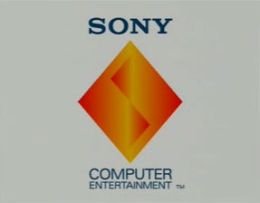 <embed height="196" src="http://wikifoundrytools.com/wiki/closinglogos/widget/youtubevideo/8872f882ec625c84b9e685564190aba49ee38654" type="application/x-shockwave-flash" width="241" wmode="transparent"/>
<embed height="196" src="http://wikifoundrytools.com/wiki/closinglogos/widget/youtubevideo/8872f882ec625c84b9e685564190aba49ee38654" type="application/x-shockwave-flash" width="241" wmode="transparent"/>
Logo: We fade into a white background, then an orange/yellow gradient diamond appears. After that, two triangles appear on the diamond in an "S" shape. After it's completed:
appears in a dark blue color, with "SONY" in its corporate font (actually a variation of the Clarendon typeface font).
Variants:
FX/SFX: The diamond, two triangles, and text appearing.
Music/Sounds: A synth bass note with chimes ringing, followed by another bass note, which often continues to the PlayStation logo of the time. Note that the music starts before we even fade into the white background.
Background: Sony Interactive Entertainment (SIE formerly "Sony Network Entertainment" and "Sony Computer Entertainment") was founded and established on November 16, 1993 in Tokyo, Japan as a subsidiary of Sony to create the PlayStation video game console. The PlayStation was the result of Nintendo and Sony teaming up to try to create a CD add-on for the Super Nintendo Entertainment System (SNES for short). However, the deal said that Sony must license the SNES-CD games and not Nintendo. This betrayed Nintendo, and they asked Philips to create the add-on, and the deal was accepted. Once Sony heard about Nintendo and Philips' collaboration which gave Sony "a taste of their own medicine", they went on to independently develop a CD-based game console, the PlayStation. It was a success, leaving Sony to make more PlayStation consoles (including the PlayStation 2, which has gone on to become the best-selling console of all time, at sales of over 150 million units worldwide), even a portable console called the PSP. Philips went on to create four video games for their CD-i, since they still had some of the licenses from Nintendo's characters. They continued to make a successful line of consoles and handhelds, such as the PlayStation 3, the PlayStation Vita, and most recently the PlayStation 4. In April 2016, Sony Computer Entertainment and Sony Network Entertainment was restructured and reorganized into Sony Interactive Entertainment, carrying over the operations and primary objectives from both companies.
1st Logo
(December 3, 1994-March 23, 2006, December 3, 2018- )
 <embed height="196" src="http://wikifoundrytools.com/wiki/closinglogos/widget/youtubevideo/8872f882ec625c84b9e685564190aba49ee38654" type="application/x-shockwave-flash" width="241" wmode="transparent"/>
<embed height="196" src="http://wikifoundrytools.com/wiki/closinglogos/widget/youtubevideo/8872f882ec625c84b9e685564190aba49ee38654" type="application/x-shockwave-flash" width="241" wmode="transparent"/>Logo: We fade into a white background, then an orange/yellow gradient diamond appears. After that, two triangles appear on the diamond in an "S" shape. After it's completed:
SONY
COMPUTER
ENTERTAINMENT
COMPUTER
ENTERTAINMENT
appears in a dark blue color, with "SONY" in its corporate font (actually a variation of the Clarendon typeface font).
Variants:
- On earlier generation PlayStation consoles (SCPH-100x series to SCPH-555x series), the Sony Computer Entertainment text is larger and the trademark symbol is on the right of the diamond instead of the "COMPUTER ENTERTAINMENT" text.
- From the SCPH-700x onwards, however, the SCE text is a bit smaller. Also on pretty much all the original PlayStation consoles, when the above logo appears, a TM sign appears next to the logo.
- On the PSone, a registered trademark sign appears next to the logo.
- On very early Japan-region consoles, the sound can still be heard fading out over the menu screen
- On the PlayStation Classic, the diamond is smaller and moved to the left, and “Sony Interactive Entertainment” fades in next to it..
FX/SFX: The diamond, two triangles, and text appearing.
Music/Sounds: A synth bass note with chimes ringing, followed by another bass note, which often continues to the PlayStation logo of the time. Note that the music starts before we even fade into the white background.
Music/Sounds Trivia: The music's sequence is generated by 3 integrated PCM sound files which come from the BIOS software (the chimes, bass note and a "shattering"-like reversed sound); all of them are being played in different speeds and pitches than the original samples (also processed in reverb). This is also the same with the following PlayStation logo.
Availability: Appears when you turn on a Sony PlayStation or its compact re-design, the PSone. Still used as a print logo on slipcases of first-party PlayStation games. The logo is obviously not seen when you play a PlayStation 1 game on the PlayStation 2 or 3.
Editor’s Note: Many people consider this one of the greatest console startups due to its unique sound and nostalgia factor.
Editor’s Note: Many people consider this one of the greatest console startups due to its unique sound and nostalgia factor.
2nd Logo
(December 3, 1994- )
Logo: On a plain black background, we see text saying:
in a Helvetica-like font.It usually appears after the PlayStation logo on Japanese/NTSC-J and North American/NTSC-U/C PlayStation games, but on European/PAL games, it usually appears after the piracy warning (which is common on PAL PlayStation games from 1995 to 1999).
Variant: Like the first PlayStation logo, there are regional variants. The version mentioned above is normally used on games from Japan, but there are also North American and European variants. There are also countless other variants of this logo, for instance, font differences and backgrounds. Later versions say “Sony Computer Entertainment presents” and most recently, “Sony Interactive Entertainment presents”.
FX/SFX: None or the fading in/fading out.
Music/Sounds: None or some music from the game.
Availability: Common. It appears on many games developed and/or published by Sony Computer Entertainment for the PlayStation consoles. The first game to use this logo was the Japan-only PlayStation launch title Crime Crackers.
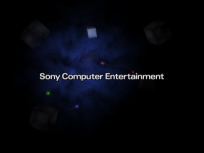
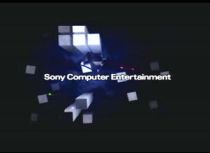
<embed height="158" src="http://wikifoundrytools.com/wiki/closinglogos/widget/youtubevideo/1944e9761fbcfe34defb264c77465f484645fb42" type="application/x-shockwave-flash" width="188" wmode="transparent"/><embed height="157" src="http://wikifoundrytools.com/wiki/closinglogos/widget/youtubevideo/ddb3fbd14304c74cf64dc350c40946fd9437cfc6" type="application/x-shockwave-flash" width="191" wmode="transparent"/>
Logo: On a black background with blue clouds and 5 dark, giant glass cubes, we see "Sony Computer Entertainment" in white fade in and fade out in the span of a few seconds. We also see four comets, colored blue, green, pink, and red (possibly to represent the colors of the shapes [X, Triangle, Square, and Circle, respectively] you find on the round buttons on a PlayStation controller). We slowly zoom into the blue cloud, tilting as we do so. After a few seconds, depending on a few things explained below, we suddenly zoom in and go to either the main menu, the PlayStation Broadband Navigator, the "Red Screen of Death" variant listed below, the PS2 logo, the PS1 logo, or the start of the DVD/CD if one is inserted.
Variants:
FX/SFX: The text fading in and out, the zoom-in onto the cloud.
Music/Sounds: A whooshing, breathy synth jingle with bells, followed by a whoosh when we zoom into the cloud. When a PlayStation disc, a DVD/CD, or a hard drive is inside the PS2, there is no whoosh when we zoom into the cloud.
(December 3, 1994- )
Logo: On a plain black background, we see text saying:
Sony Computer Entertainment Inc.
Presents
Presents
in a Helvetica-like font.It usually appears after the PlayStation logo on Japanese/NTSC-J and North American/NTSC-U/C PlayStation games, but on European/PAL games, it usually appears after the piracy warning (which is common on PAL PlayStation games from 1995 to 1999).
Variant: Like the first PlayStation logo, there are regional variants. The version mentioned above is normally used on games from Japan, but there are also North American and European variants. There are also countless other variants of this logo, for instance, font differences and backgrounds. Later versions say “Sony Computer Entertainment presents” and most recently, “Sony Interactive Entertainment presents”.
FX/SFX: None or the fading in/fading out.
Music/Sounds: None or some music from the game.
Availability: Common. It appears on many games developed and/or published by Sony Computer Entertainment for the PlayStation consoles. The first game to use this logo was the Japan-only PlayStation launch title Crime Crackers.
3rd Logo
(March 4, 2000-January 4, 2013)

<embed height="158" src="http://wikifoundrytools.com/wiki/closinglogos/widget/youtubevideo/1944e9761fbcfe34defb264c77465f484645fb42" type="application/x-shockwave-flash" width="188" wmode="transparent"/><embed height="157" src="http://wikifoundrytools.com/wiki/closinglogos/widget/youtubevideo/ddb3fbd14304c74cf64dc350c40946fd9437cfc6" type="application/x-shockwave-flash" width="191" wmode="transparent"/>
Logo: On a black background with blue clouds and 5 dark, giant glass cubes, we see "Sony Computer Entertainment" in white fade in and fade out in the span of a few seconds. We also see four comets, colored blue, green, pink, and red (possibly to represent the colors of the shapes [X, Triangle, Square, and Circle, respectively] you find on the round buttons on a PlayStation controller). We slowly zoom into the blue cloud, tilting as we do so. After a few seconds, depending on a few things explained below, we suddenly zoom in and go to either the main menu, the PlayStation Broadband Navigator, the "Red Screen of Death" variant listed below, the PS2 logo, the PS1 logo, or the start of the DVD/CD if one is inserted.
Variants:
- How long we zoom into the blue cloud depends on a few factors; whenever there is a hard disk inserted, if the hard disk is corrupted, if the PSBBN is installed in the HDD, how long the console takes to boot up the software, etc. It ranges from instantaneous to about twenty seconds.
- Depending on how much data you have on a PS2 Memory Card, there will be white blocks all over the screen when you turn on the PS2. This only happens if a Memory Card and/or Memory Cards with saved data is inserted into the Memory Card slots. As the player plays a game more and more, its block will become an ever-growing tower with a misty trail behind it. The screen will be empty (as the picture on the top left shows) if there is no Memory Card inserted.
- There is also a variant referred to as the "Red Screen of Death." After we zoom into the blue clouds, we see red clouds of mist or smoke spiraling around a moving red light. A glass cube zooms into view and starts to revolve around the light as a message appears saying "Please insert a PlayStation or PlayStation 2 format disc." (this appears in a different language depending on what language your PlayStation 2 is set on, e.g. "Por favor, inserte un disco de formato PlayStation o PlayStation 2." in Spanish). Another glass cube that is further away from us comes into view from behind the text, and also revolves around the light.
- When you first set up the PS2, after we zoom into the blue cloud, the "PS" symbol fades in, then fades out, with the "PS2" logo fading in, then out. The music can still be heard on both logos.
FX/SFX: The text fading in and out, the zoom-in onto the cloud.
Music/Sounds: A whooshing, breathy synth jingle with bells, followed by a whoosh when we zoom into the cloud. When a PlayStation disc, a DVD/CD, or a hard drive is inside the PS2, there is no whoosh when we zoom into the cloud.
Music/Sounds Trivia: Similarly to the 1st logo, the music is generated from a sequence of different PCM audio files from the BIOS software (with about 17 included), all played in different pitches and playback speeds. The other sounds available are used for the RSoD screen, the PS2 logo, and the menu.
6th Logo
(February 12, 2012- )
Logo: We see the words "Sony Computer Entertainment" against a black background.
FX/SFX: None.
Music/Sounds: None on the Vita version, but the PS4 version has a tense synth sounder (which is actually the opening notes of the tune you hear at the initial setup screen).
Availability: Seen only when booting up a PS Vita or a PS4 for the first time.
Music/Sounds Variants: When the red background appears, there is a more tense synth jingle with a breathy humming sound, followed by the sounds of wind blowing and waves flowing.
Availability: Appears when you turn on a PlayStation 2. The "Red Screen of Death" only appears when an unreadable disc (or a disc that is not a PS, PS2, DVD, or Audio CD disc) is inserted.
Editor's Note: This is another nostalgic logo among gamers; however, the “Red Screen of Death” variant can catch many off guard.
Editor's Note: This is another nostalgic logo among gamers; however, the “Red Screen of Death” variant can catch many off guard.
4th Logo
(December 12, 2004-December 2014)
Note: A high-quality audio-only file of the logo can be heard <a href="https://instaud.io/private/48ad076b4338445f68145b61e10260e7942b54d3" target="_self">here</a>.
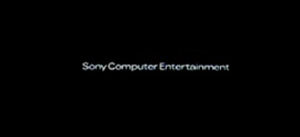 Logo: On a black background, text reading "Sony Computer Entertainment" in white as positioned on the center of the screen. Behind it is a line of color starting to emerge. The text fades out and the line emerges, revealing a moving lava lamp-like background in a color depending on the month or selected in the settings. The XMB interface appears when there is no UMD in the latch or the UMD Auto-Start is turned off.
Logo: On a black background, text reading "Sony Computer Entertainment" in white as positioned on the center of the screen. Behind it is a line of color starting to emerge. The text fades out and the line emerges, revealing a moving lava lamp-like background in a color depending on the month or selected in the settings. The XMB interface appears when there is no UMD in the latch or the UMD Auto-Start is turned off.
(December 12, 2004-December 2014)
Note: A high-quality audio-only file of the logo can be heard <a href="https://instaud.io/private/48ad076b4338445f68145b61e10260e7942b54d3" target="_self">here</a>.
 Logo: On a black background, text reading "Sony Computer Entertainment" in white as positioned on the center of the screen. Behind it is a line of color starting to emerge. The text fades out and the line emerges, revealing a moving lava lamp-like background in a color depending on the month or selected in the settings. The XMB interface appears when there is no UMD in the latch or the UMD Auto-Start is turned off.
Logo: On a black background, text reading "Sony Computer Entertainment" in white as positioned on the center of the screen. Behind it is a line of color starting to emerge. The text fades out and the line emerges, revealing a moving lava lamp-like background in a color depending on the month or selected in the settings. The XMB interface appears when there is no UMD in the latch or the UMD Auto-Start is turned off.Variant: On development kits running the pre-release 1.00 firmware, known as "Bogus", the text reads "Sony Computer Entertainment Inc." The music consists of a whoosh, and a dreamy synth crescendo.
FX/SFX: Just the background moving.
Music/Sounds: A soft and short five note synth-chime tune.
Availability: This can be seen when you boot up a Sony PSP (not from stand-by mode), but if the theme is changed on a hacked PSP, you might not be able to see it. The "Bogus" variant is extremely rare.
Music/Sounds: A soft and short five note synth-chime tune.
Availability: This can be seen when you boot up a Sony PSP (not from stand-by mode), but if the theme is changed on a hacked PSP, you might not be able to see it. The "Bogus" variant is extremely rare.
5th Logo
(November 11, 2006-September 1, 2009)
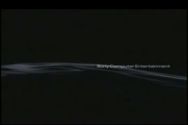
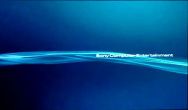
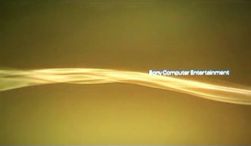
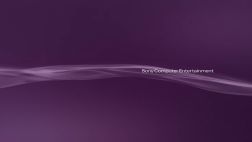
<embed height="149" src="http://wikifoundrytools.com/wiki/closinglogos/widget/youtubevideo/b7569ffe61fa338562f92e104b18740e276d9a48" type="application/x-shockwave-flash" width="186" wmode="transparent"/><iframe frameborder="0" height="150" src="http://wikifoundrytools.com/wiki/closinglogos/widget/genericvideo/91c54584ff2a5b5f4c505f66bb61a2a2608e2840" width="266"></iframe>
Logo: Against a blue background, we see a series of silvery lines waving up and down. The words "Sony Computer Entertainment" in white fade in on the right.
Variant: The color of the background varies depending on the month it is set to (the colors can be set manually, however). Blue or black is the default color and a gold background exists. A version with a purple background.
FX/SFX: The lines wavering.
Music/Sounds: An orchestra of string and woodwind instruments warming up, Sounding like the orchestra in the THX Cimarron trailer. After the September 1, 2009 update, the sound was changed slightly.
Availability: Extremely rare. Seen when you boot up any PlayStation 3 that has firmware below 3.00, which might be hard to find on sites like eBay. As of the September 1, 2009 update, the startup has been changed to display the PlayStation Family logo and the new PS3 logo, in place of the Sony Computer Entertainment logo.
(November 11, 2006-September 1, 2009)




<embed height="149" src="http://wikifoundrytools.com/wiki/closinglogos/widget/youtubevideo/b7569ffe61fa338562f92e104b18740e276d9a48" type="application/x-shockwave-flash" width="186" wmode="transparent"/><iframe frameborder="0" height="150" src="http://wikifoundrytools.com/wiki/closinglogos/widget/genericvideo/91c54584ff2a5b5f4c505f66bb61a2a2608e2840" width="266"></iframe>
Logo: Against a blue background, we see a series of silvery lines waving up and down. The words "Sony Computer Entertainment" in white fade in on the right.
Variant: The color of the background varies depending on the month it is set to (the colors can be set manually, however). Blue or black is the default color and a gold background exists. A version with a purple background.
FX/SFX: The lines wavering.
Music/Sounds: An orchestra of string and woodwind instruments warming up, Sounding like the orchestra in the THX Cimarron trailer. After the September 1, 2009 update, the sound was changed slightly.
Availability: Extremely rare. Seen when you boot up any PlayStation 3 that has firmware below 3.00, which might be hard to find on sites like eBay. As of the September 1, 2009 update, the startup has been changed to display the PlayStation Family logo and the new PS3 logo, in place of the Sony Computer Entertainment logo.
6th Logo
(February 12, 2012- )
Logo: We see the words "Sony Computer Entertainment" against a black background.
FX/SFX: None.
Music/Sounds: None on the Vita version, but the PS4 version has a tense synth sounder (which is actually the opening notes of the tune you hear at the initial setup screen).
Availability: Seen only when booting up a PS Vita or a PS4 for the first time.